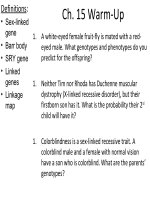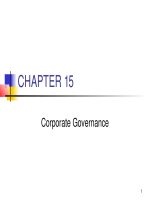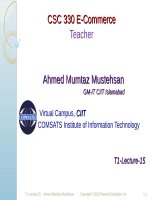Lecture biology (6e) chapter 15 campbell, reece
Bạn đang xem bản rút gọn của tài liệu. Xem và tải ngay bản đầy đủ của tài liệu tại đây (1.06 MB, 69 trang )
CHAPTER 15
THE CHROMOSOMAL BASIS OF
INHERITANCE
Section A: Relating Mendelism to Chromosomes
1. Mendelian inheritance has its physical basis in the behavior of
chromosomes during sexual life cycles
2. Morgan traced a gene to a specific chromosome
3. Linked genes tend to be inherited together because they are located on the
same chromosome
4. Independent assortment of chromosomes and crossing over produce genetic
recombinants
5. Geneticists use recombination data to map a chromosome’s genetic loci
Copyright © 2002 Pearson Education, Inc., publishing as Benjamin Cummings
Introduction
ã Itwasnotuntil1900thatbiologyfinallycaughtup
withGregorMendel.
ã Independently,KarlCorrens,ErichvonTschermak,
andHugodeVriesallfoundthatMendelhad
explainedthesameresults35yearsbefore.
ã Still,resistanceremainedaboutMendelslawsof
segregationandindependentassortmentuntil
evidencehadmountedthattheyhadaphysicalbasis
inthebehaviorofchromosomes.
ã Mendelshereditaryfactorsarethegeneslocatedon
chromosomes.
Copyrightâ2002PearsonEducation,Inc.,publishingasBenjaminCummings
1.Mendelianinheritancehasitsphysical
basisinthebehaviorofchromosomes
duringsexuallifecycles
ã Around1900,cytologistsandgeneticistsbeganto
seeparallelsbetweenthebehaviorofchromosomes
andthebehaviorofMendelsfactors.
ã Chromosomesandgenesarebothpresentinpairsin
diploidcells.
ã Homologouschromosomesseparateandallelessegregate
duringmeiosis.
ã Fertilizationrestoresthepairedconditionforboth
chromosomesandgenes.
Copyrightâ2002PearsonEducation,Inc.,publishingasBenjaminCummings
• Around 1902, Walter Sutton, Theodor Boveri, and
others noted these parallels and a chromosome
theory of inheritance began to take form.
Fig. 15.1
Copyright © 2002 Pearson Education, Inc., publishing as Benjamin Cummings
2.Morgantracedagenetoaspecific
chromosome
ã ThomasHuntMorganwasthefirsttoassociatea
specificgenewithaspecificchromosomeinthe
early20thcentury.
ã LikeMendel,Morganmadeaninsightfulchoiceas
anexperimentalanimal,Drosophilamelanogaster,a
fruitflyspeciesthateatsfungionfruit.
ã Fruitfliesareprolificbreedersandhaveagenerationtime
oftwoweeks.
ã Fruitflieshavethreepairsofautosomesandapairofsex
chromosomes(XXinfemales,XYinmales).
Copyrightâ2002PearsonEducation,Inc.,publishingasBenjaminCummings
• Morgan spent a year looking for variant
individuals among the flies he was breeding.
• He discovered a single male fly with white eyes instead
of the usual red.
• The normal character phenotype is the wild type.
• Alternative
traits are
mutant
phenotypes.
Fig. 15.2
Copyright © 2002 Pearson Education, Inc., publishing as Benjamin Cummings
• When Morgan crossed his whiteeyed male with a
redeyed female, all the F1 offspring had red eyes,
• The red allele appeared dominant to the white allele.
• Crosses between the F1 offspring produced the
classic 3:1 phenotypic ratio in the F2 offspring.
• Surprisingly, the whiteeyed trait appeared only in
males.
• All the females and half the males had red eyes.
• Morgan concluded that a fly’s eye color was linked
to its sex.
Copyright © 2002 Pearson Education, Inc., publishing as Benjamin Cummings
• Morgan deduced that the gene
with the whiteeyed mutation is
on the X chromosome alone, a
sexlinked gene.
• Females (XX) may have two red
eyed alleles and have red eyes or
may be heterozygous and have red
eyes.
• Males (XY) have only a single
allele and will be red eyed if they
have a redeyed allele or white
eyed if they have a whiteeyed
allele.
Fig. 15.3
Copyright © 2002 Pearson Education, Inc., publishing as Benjamin Cummings
3.Linkedgenestendtobeinherited
togetherbecausetheyarelocatedonthe
samechromosome
ã Eachchromosomehashundredsorthousandsof
genes.
ã Geneslocatedonthesamechromosome,linked
genes,tendtobeinheritedtogetherbecausethe
chromosomeispassedalongasaunit.
ã Resultsofcrosseswithlinkedgenesdeviatefrom
thoseexpectedaccordingtoindependentassortment.
Copyrightâ2002PearsonEducation,Inc.,publishingasBenjaminCummings
• Morgan observed this linkage and its deviations
when he followed the inheritance of characters for
body color and wing size.
• The wildtype body color is gray (b+) and the mutant
black (b).
• The wildtype wing size is normal (vg+) and the mutant
has vestigial wings (vg).
• Morgan crossed F1 heterozygous females
(b+bvg+vg) with homozygous recessive males
(bbvgvg).
Copyright © 2002 Pearson Education, Inc., publishing as Benjamin Cummings
• According to independent assortment, this should produce 4
phenotypes in a 1:1:1:1 ratio.
• Surprisingly, Morgan observed a large number of wildtype
(graynormal) and doublemutant (blackvestigial) flies among
the offspring.
• These phenotypes correspond to those of the parents.
Copyright © 2002 Pearson Education, Inc., publishing as Benjamin Cummings
Fig. 15.4
Copyright © 2002 Pearson Education, Inc., publishing as Benjamin Cummings
• Morgan reasoned that body color and wing shape
are usually inherited together because their genes
are on the same chromosome.
QuickTime™ and a
GIF decompressor
are needed to see this picture.
Copyright © 2002 Pearson Education, Inc., publishing as Benjamin Cummings
• The other two phenotypes (grayvestigial and
blacknormal) were fewer than expected from
independent assortment (and totally unexpected
from dependent assortment).
• These new phenotypic variations must be the result
of crossing over.
4.Independentassortmentofchromosomes
andcrossingoverproducegenetic
recombinants
ã Theproductionofoffspringwithnewcombinations
oftraitsinheritedfromtwoparentsisgenetic
recombination.
ã Geneticrecombinationcanresultfromindependent
assortmentofgeneslocatedonnonhomologous
chromosomesorfromcrossingoverofgeneslocated
onhomologouschromosomes.
Copyrightâ2002PearsonEducation,Inc.,publishingasBenjaminCummings
• Mendel’s dihybrid cross experiments produced some
offspring that had a combination of traits that did
not match either parent in the P generation.
• If the P generation consists of a yellowround parent
(YYRR) crossed with a greenwrinkled seed parent (yyrr),
all F1 plants have yellowround seeds (YyRr).
• A cross between an F1 plant and a homozygous recessive
plant (a testcross) produces four phenotypes.
• Half are be parental types, with phenotypes that match
the original P parents, either with yellowround seeds or
greenwrinkled seeds.
• Half are recombinants, new combination of parental
traits, with yellowwrinkled or greenround seeds.
Copyright © 2002 Pearson Education, Inc., publishing as Benjamin Cummings
• A 50% frequency of recombination is observed for
any two genes located on different
(nonhomologous) chromosomes.
• The physical basis of recombination between
unlinked genes is the random orientation of
homologous chromosomes at metaphase 1.
• The F1 parent (YyRr) can produce gametes with four
different combinations of alleles.
• These include YR, Yr, yR, and yr.
• The orientation of the tetrad containing the seed color
gene has no bearing on the orientation on the tetrad
with the seed shape gene.
Copyright © 2002 Pearson Education, Inc., publishing as Benjamin Cummings
• In contrast, linked genes, genes located on the
same chromosome, tend to move together through
meiosis and fertilization.
• Under normal Mendelian genetic rules, we would
not expect linked genes to recombine into
assortments of alleles not found in the parents.
• If the seed color and seed coat genes were linked, we
would expect the F1 offspring to produce only two types
of gametes, YR and yr when the tetrads separate.
• One homologous chromosome from a P generation
parent carries the Y and R alleles on the same
chromosome and the other homologous chromosome
from the other P parent carries the y and r alleles.
Copyright © 2002 Pearson Education, Inc., publishing as Benjamin Cummings
• The results of Morgan’s testcross for body color
and wing shape did not conform to either
independent assortment or complete linkage.
• Under independent assortment the testcross should
produce a 1:1:1:1 phenotypic ratio.
• If completely linked, we should expect to see a 1:1:0:0
ratio with only parental phenotypes among offspring.
• Most of the offspring had parental phenotypes,
suggesting linkage between the genes.
• However, 17% of the flies were recombinants,
suggesting incomplete linkage.
Copyright © 2002 Pearson Education, Inc., publishing as Benjamin Cummings
• Morgan proposed that some mechanism
occasionally exchanged segments between
homologous chromosomes.
• This switched alleles between homologous
chromosomes.
• The actual mechanism, crossing over during
prophase I, results in the production of more types
of gametes than one would predict by Mendelian
rules alone.
Fig. 15.5a
Copyright © 2002 Pearson Education, Inc., publishing as Benjamin Cummings
• The occasional production of recombinant gametes
during prophase I accounts for the occurrence of
recombinant phenotypes in Morgan’s testcross.
Fig. 15.5b
Copyright © 2002 Pearson Education, Inc., publishing as Benjamin Cummings
5.Geneticistscanuserecombinationdatato
mapachromosomesgeneticloci
ã OneofMorgansstudents,AlfredSturtevant,used
crossingoveroflinkedgenestodevelopamethod
forconstructingageneticmap.
ã Thismapisanorderedlistofthegeneticlocialonga
particularchromosome.
Copyrightâ2002PearsonEducation,Inc.,publishingasBenjaminCummings
• Sturtevant hypothesized that the frequency of
recombinant offspring reflected the distances
between genes on a chromosome.
• The farther apart two genes are, the higher the
probability that a crossover will occur between
them and therefore a higher recombination
frequency.
• The greater the distance between two genes, the more
points between them where crossing over can occur.
• Sturtevant used recombination frequencies from
fruit fly crosses to map the relative position of
genes along chromosomes, a linkage map.
Copyright © 2002 Pearson Education, Inc., publishing as Benjamin Cummings
• Sturtevant used the testcross design to map the
relative position of three fruit fly genes, body color
(b), wing size (vg), and eye color (cn).
• The recombination frequency between cn and b is 9%.
• The recombination frequency between cn and vg is
9.5%.
• The recombination frequency between b and vg is 17%.
• The only possible
arrangement of these
three genes places
the eye color gene
between the other two.
Fig. 15.6
Copyright © 2002 Pearson Education, Inc., publishing as Benjamin Cummings
• Sturtevant expressed the distance between genes,
the recombination frequency, as map units.
• One map unit (sometimes called a centimorgan) is
equivalent to a 1% recombination frequency.
• You may notice that the three recombination
frequencies in our mapping example are not quite
additive: 9% (bcn) + 9.5% (cnvg) > 17% (bvg).
• This results from multiple crossing over events.
• A second crossing over “cancels out” the first and
reduces the observed number of recombinant offspring.
• Genes father apart (for example, bvg) are more likely to
experience multiple crossing over events.
Copyright © 2002 Pearson Education, Inc., publishing as Benjamin Cummings









